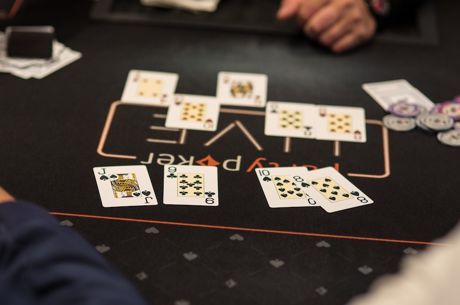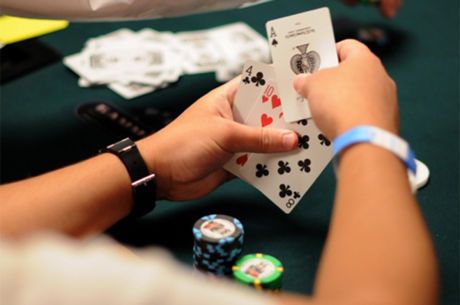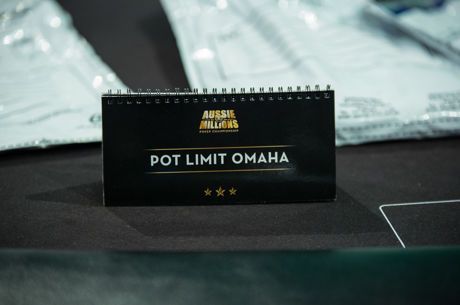Ready to Plug Some Leaks in your Pot Limit Omaha game?

Table Of Contents
This article will go over five preflop mistakes that more than 80% of PLO players make.
The first three sections will help you improve your approach when open-raising and playing versus open-raises. The final two sections cover more general concepts and will be especially helpful for live PLO players.
Note: This article is based on the first video in a four-part PLO strategy series by Chris Wehner and Dylan Weisman.
Both Dylan and Chris are PLO pros who crush games as high as $25/$50 and $50/$100.
If you want to take your PLO game to the highest level, check out their Advanced PLO Mastery course that was just released on upswingpoker.com.
Mistakes in Open-Raising Situations
1. Entering the pot via passive action with too many hands.
No matter what poker game you're playing, passive preflop actions come with a huge downside:
- You never get to win the pot preflop when you take a passive action. When you factor in rake, the expected value (EV) of these passive actions takes a huge hit.
- Passive actions are especially unappealing in PLO because hand equities run so closely together. You will win the pot a lower percentage of the time, making it very difficult to beat the rake.
- Therefore, you should generally avoid entering the pot via a passive action in micro and low stakes PLO games. This includes cold-calling versus raises and open-limping (even in blind vs blind situations).
This advice is absolutely crucial in low stakes games, where your win-rate will be decimated by high rake, but it��s not as much of a big deal in mid and high stakes games.
Play solid opening ranges, cut out the passive actions, and watch your profit soar. (Extensive preflop ranges are included in the Advanced PLO Mastery course.)
2. Playing too many hands with low, unconnected cards.
You should seldom play starting hands that contain low cards that don't interact with each other.
For example, a hand like A?J?6?2? might seem like it's worth raising from middle position, but it's really only a profitable raise when you're on the button.
These types of hands simply don't have enough playability to justify entering the pot with multiple players behind you. Dylan shared some insight into what Monker Solver (the premier solver for PLO) thinks of these hands:
Monker Solver, generally speaking, hates cards below a 5 in your opening hand.
This is a really good heuristic to take into your day-to-day games because it's gonna help you start to cultivate opening ranges that will play well over multiple streets, as well as multiway or whatever situation you're most likely to find yourself in.
3. Opening all of your KK combinations from every position.
Pocket kings is a strong hand in PLO, but your side cards really matter. Put simply, some KKxx hands are not worth playing in some preflop situations.
Folding a hand with two kings will hurt, but you've got to be prepared to do it in certain spots.
For example, only 78% of single suited KxKxXxXx combinations are profitable raises from UTG at a 6-handed table (according to Monker Solver). The worst KxKxXxXx hands you should raise UTG are K?K?5?2? and K?K?5?4?. Every worse version of pocket kings needs to hit the muck.
Double suited kings, by contrast, are played at a 100% frequency from UTG by Monker Solver.
General Preflop Mistakes Live PLO Players Often Make
I know a lot of you play live PLO, so these mistakes to avoid are (mainly) for you.
4. Entering multiway pots via passive actions with too wide of a range.
Suppose you're at a live PLO table and a player raises in early position. A couple of players call by the time the action gets to you.
Should you play a wide range of hands in this situation?
Whether you're on the button or defending your big blind, the answer is a resounding no.
Live PLO players tend to call way too wide in multiway situations, likely because of their seemingly good pot odds. I'll let Dylan explain this further:
There's this logical fallacy that pot odds allow you to enter the pot [versus multiple players] when you're getting six to one, seven to one, or eight to one.
This especially is not true in PLO because:
- You're more likely to make hands and
- You're way more likely to be dominated when you make those hands if there are more players in the pot and if those players are playing somewhat reasonable ranges.
Dylan goes on to explain an example.
Suppose there is a raise from UTG, a call in the cutoff, and a call on the button. You call in the big blind with J?8?6?5?.
The flop comes K?7?2?.
When you check and the UTG player c-bets �� which they won't be doing very often �� they're going to have an incredibly strong range. They can have:
- AxAxKxXx combinations with an ace-high flush draw.
- KxKxXxXx combinations that also have some hearts in them.
Your hand is going to play terribly against UTG's c-betting range (even if they also c-bet with some weaker hands as well).
When you make your flush, you're quite likely to be dominated. So, not only did you burn some money preflop, you also have substantial reverse implied odds. This will get you into a ton of trouble.
You can plug this leak by never calling in multiway preflop situations with hands that can't make the nuts often. In other words, fold hands that aren't high pocket pairs and/or don't have nut flush draws. This will help you avoid difficult and unprofitable situations.
5. Never 4-betting as a bluff.
Once upon a time (2009 to be exact) No Limit Hold'em players would never 4-bet without aces, and maybe kings. When someone put in the fourth bet preflop, you could confidentially narrow their holdings to one of those two super premium hands.
That time has long passed in No Limit Hold'em, but most Pot Limit Omaha players are still stuck in that same mindset.
If you're trying to build a modern game, you need to be capable of 4-bet bluffing to restrain the aggression of other players. The worst thing that can happen to a player who 3-bets too often is to face a 4-bet.
Generally speaking, we generate EV by playing aggressively. By not building a well-balanced 4-betting strategy, you allow your opponents to run you over, which effectively transfers EV from your strategy (and bankroll) to theirs.
What types of hands should you use as 4-bet bluffs? Let's kick it back to Dylan:
You will want to construct this [4-bet] range in a way that you don't get punished super often. This means:
- You're not getting it in bad against aces.
- You have a high probability of generating folds.
- It's kind of easy to think about.
My intention for people watching this video is to get a basic understanding of building a 4-betting range. To get into the nitty gritty, dive into the PLO Matrix or get our course when it comes out in March. [Chris Wehner and I] have multiple videos on 4-betting in the course.
I'm gonna give you some do's and don'ts for 4-bet bluffing.
The Do's and Don't of 4-Bet Bluffing in PLO
- You DO want a hand that contains an ace (in order to block AxAxXxXx hands).
- You DO want a hand with great playability (in case your opponent calls).
- You DON'T want a hand that contains a king (because you want your opponent to have KxKxXxXx, which he should fold).
For example, a hand like A?Q?J?8? is a super effective 4-bet bluff. It blocks AxAxXxXx, doesn't block KxKxXxXx, and will perform very well on the flop with a low stack-to-pot ratio.
On the other hand, A?K?8?7? is not an effective 4-bet bluff. It might have good playability and block AxAxXxXx, but blocking KxKxXxXx is horrible since that's exactly what you want your opponent to have. Plus, it plays great as a 3-bet calling hand.
I'll leave you with some motivational words from Dylan:
When you're in the streets, start to push yourself. Don't just 4-bet with aces. Really start to think about ways where you can generate aggression that will [make you difficult to play against] and start to push your game to a more modern structure...
...which I think is really important in 2020.
If you want to keep improving your PLO game for free, watch the next part of this strategy series.
Want to absolutely dominate PLO games? Get the brand new Advanced PLO Mastery course, the most cutting-edge course ever made for this game type. Learn more now!
Sponsor generated content by Upswing Poker









